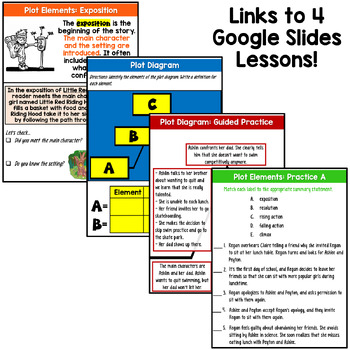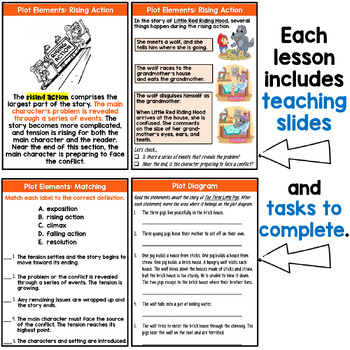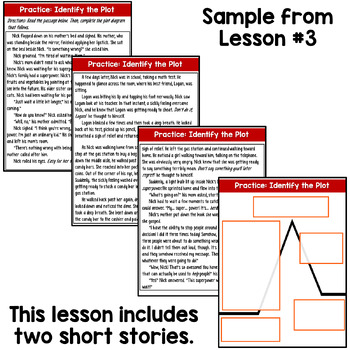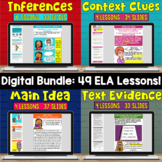Plot Elements: Four Digital Lessons Using Google Slides
- Google Drive™ folder
- Internet Activities

What educators are saying
Also included in
- This bundle of resources contains all of my digital ELA lessons. It is compatible with Google Slides. The bundle features twelve ELA topics. Most topics includes 4 lessons. (The only exceptions are my figurative language set which includes seven lessons, and my free character traits set which includPrice $45.99Original Price $57.89Save $11.90
Description
This digital plot elements resource features four complete lessons. It is compatible with Google Slides. The lessons feature both instructional slides AND practice slides where students complete a task related to the instructional slides. Use these plot element activities over the course of four days to provide targeted instruction for your students. They can be used as a large group activity, in a small group setting, OR as an engaging self-paced reading lesson.
The slides in each lesson progress from basic to more complex. Answer keys are included. CHECK OUT THE PREVIEW to see some of the slides in these lessons.
Lesson #1: Introduction to Plot Elements (11 slides)
-This lesson includes seven instructional slides. This lesson begins by showing a complete plot diagram that is in the form of a cartoon. Then each plot element is presented individually. Along with being given a complete definition for each plot element, students are asked to consider how each element is present in the story of Little Red Riding Hood.
-The lesson contains three practice slides. On the first practice slide, students complete a matching activity where they match the plot element term with the correct definition. On the second practice slide, students are tasked with labeling the five parts of a plot diagram. On the final practice slide, read statements about The Three Little Pigs, and they identify the plot element being summarized in each statement.
Lesson #2: Digging Deeper Into Plot Elements (10 slides)
-This lesson begins with two review slides. Students are presented with a plot diagram, and they must label each part of the diagram AND write a definition for each term. (I picture students and teachers working together to complete these slides, but students can also work independently and refer to yesterday's lesson if they need help with the definitions.)
- The lesson continues with two instructional slides. On these two slides, students take a closer look at "rising action" and "climax". As they look at these plot elements, they are asked to consider how they apply to the story of Goldilocks and the Three Bears.
- The lesson contains four practice slides. On the first two practice slides, students are given a story summary, and they must highlight the climax in each story. For the final activity, students are asked to fill out a plot diagram for the story of Cinderella. (Picture clues are provided.)
Lesson #3: Two Short Stories and Plot Diagrams (10 slides)
-The first five slides are designed to be a guided practice activity. After reading the short story, students are asked if they think they can fill out a plot diagram for the short story. Then they are told that the plot diagram on the next slides is finished, but it is covered with colored boxes. They are told to consider what THEY would write in each box, and then to move the box to see if their answer was correct.
-The final four slides are designed to be an independent practice activity. Students read another short story. This time, they type in the boxes to fill out the plot diagram that follows.
Lesson #4: Putting It All Together/Test Prep (7 slides)
-This lesson has two practice activities. First, students read a story and then complete the matching task that follows, where students match a section of the story to the correct plot term. For the second activity, students read a short story, and then they answer a multiple-choice question where they are tasked with identifying the climax of the story.
**IMPORTANT NOTE!**
This digital lesson resource is an expanded version of my printable plot elements trifolds. Some of the practice activities in my printable trifolds are the same as the practice activities in these digital lessons. The main difference between the two versions is that this digital version offers complete lessons with additional instructional slides that are not included in the printable trifolds. I really want to stress the overlap to teachers who have previously purchased my plot trifolds so that they are aware of this overlap before they purchase this expanded, alternate version.
**Check out my FREE CHARACTER TRAITS LESSON if you want to view the structure of these lessons a bit more closely.
If you're looking for additional materials for teaching about plot elements, feel free to check out my plot bundle. (Click here!)
Click on the following links to check out my other Digital ELA Lessons!
Figurative Language: Seven Digital Lessons
Main Idea: Four Digital Lessons
Context Clues: Four Digital Lessons
Inferences: Four Digital Lessons
Author's Purpose: Four Digital Lessons
Text Evidence: Four Digital Lessons
Summarizing Fiction: Four Digital Lessons
Summarizing Nonfiction: Four Digital Lessons
Cause and Effect: Four Digital Lessons
Digital Lesson ELA BUNDLE: ALL 11 Topics
Copyright by Deb Hanson
This item is a paid digital download from my TpT store
www.teacherspayteachers.com/Store/Deb-Hanson
This product is to be used by the original downloader only. Copying for more than one teacher is prohibited. This item is also bound by copyright laws. Redistributing, editing, selling, or posting this item (or any part thereof) on an Internet site that is not password protected are all strictly prohibited without first gaining permission from the author. Violations are subject to the penalties of the Digital Millennium Copyright Act. Please contact me if you wish to be granted special permissions!






